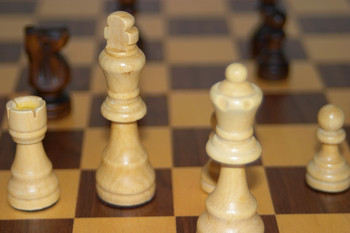How to Play Chess
Chess is a board game whose current incarnation is thought to have been developed in 15th century Europe but earlier versions were played in India. Chess is a game played by only two players. The object of Chess is to put your opponent in a situation where their King game piece cannot be prevented from being captured.
Chess Setup
Chess is played on an 8×8 checkered, black-and-white grid board. The chess pieces are initially setup in the first two rows nearest to each player. For example, the person who has chosen to use the white pieces will set up their pieces in the first two rows nearest to them. The player using the black pieces will sit opposite the other player. They will set up the black pieces in the first two rows nearest to them. For this article, we will number the rows 1-8. 1 is the closest row to a player and 8 is the farthest away. The columns will be designated A-H, meaning that the “A” column is the column on the far left and the H column is on the far right. Therefore, the square labeled 1A will be the bottom left square and the square labeled 8H will be the top right.
The board should be positioned so that the 1A and 8H squares are black. Then, in the 1 row, the white pieces are setup as follows:
- 1A: Rook
- 1B: Knight
- 1C: Bishop
- 1D: Queen
- 1E: King
- 1F: Bishop
- 1G: Knight
- 1H: Rook
In the 2 row, the white player will place a pawn in each column so there is a row of pawns in front of the other pieces.
The black pieces are set up in row 8 in exactly the same order. The black pawns are all set up straight across in row 7. When the board is completely set up, the black and white pieces should mirror each other exactly, meaning that each white piece is directly lined up with the same type of black piece.
Chess Moves, Chess Strategy, & Chess Pieces
The following list briefly details the chess moves made available to individual chess pieces along with some strategy.

How to Play Chess
Pawn: The pawn is the simplest piece in the game and is often sacrificed to try and steal the other player’s more valuable pieces. When moving out of its original row, the pawn can move one or two squares directly forward. After that, it can only move forward one square. For example, a pawn could move from 2C to 3C or 4C on its first move – then it could only move forward one square at a time. However, a pawn captures an opponent’s piece by moving diagonally forward one square to the left or right. This is the only time a pawn can move in this way and a pawn cannot capture a piece by moving forward. Pawns are considered to be the least valuable game piece and offer little in terms of chess strategy.
Rook: Rooks are the pieces that look like castle towers. They can move horizontally or vertically any number of spaces in any direction. For example, if there were no other pieces in the way, a rook could move from all the way from 3A to 3H or from 1A to 8A.
Bishop: A bishop moves diagonally any number of spaces in any direction. This means that, whatever color square a bishop is set up on initially, that piece will only occupy those color squares for the rest of the game.
Knight: The knight is the piece that looks like a horse. It has the most unique movement in that its path is shaped like an “L.” The knight moves two squares horizontally and one square vertically or one square horizontally and two squares vertically. The knight moves in any direction. It is also the only piece in chess that can jump over other pieces to reach its destination.
Queen: The queen is perhaps the most powerful piece on the board. It can move horizontally, vertically and diagonally in any direction for any number of squares. It cannot emulate the movement of the knight, however.
King: The king can move horizontally, vertically and diagonally in any direction but only one square at a time.
Chess Rules
Chess rules require that the player who is using the white pieces always goes first. Each player only moves one piece at a time. When a player lets go of a piece, the position of that piece is considered final. Because of this, many players will hold on to a piece after they’ve moved it to make sure that they’re making the move they actually want to make. A piece is captured when an opposing player’s piece lands on the same square. The piece is then removed from the board.
If a king is ever in danger of being captured, a player is said to be in “check.” A player who is in check must get out of check by any means necessary. A “checkmate” is when a player has captured the other player’s king, which constitutes winning the game. A “stalemate” is when neither player can capture the other player’s king and the game is considered a draw.
There are many special moves in chess including castling, en passant and pawn promotion. There are also different strategies that can be applied according to the timeline of the game (opening, middle game, and end game). There are hundreds of books and articles regarding chess strategy, but as long as you know the board setup and piece movements, you’re ready to dive into one of the most legendary games ever played.
For more guides about how to play chess, we recommend:
